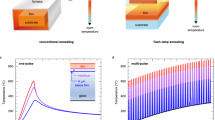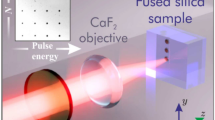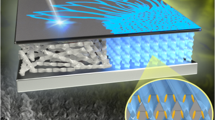Abstract
THE possibility of evaporating in vacuum an optically active film of an otherwise isotropic material, by oblique deposition on to a flat glass substrate revolving about its normal as an axis, is confirmed. The helically deposited fluorite films ranged up to about 18µ thick, and turned the plane of polarization of a normally incident beam by as much as 2.25° at λ = 0.546µ.
This is a preview of subscription content, access via your institution
Access options
Subscribe to this journal
Receive 51 print issues and online access
$199.00 per year
only $3.90 per issue
Buy this article
- Purchase on Springer Link
- Instant access to full article PDF
Prices may be subject to local taxes which are calculated during checkout
Similar content being viewed by others
References
Evans, J. W., J. Opt. Soc. Amer., 48, 142 (1958).
Reimer, L., Optik, 14, 83 (1957).
Author information
Authors and Affiliations
Rights and permissions
About this article
Cite this article
YOUNG, N., KOWAL, J. Optically Active Fluorite Films. Nature 183, 104–105 (1959). https://doi.org/10.1038/183104a0
Issue Date:
DOI: https://doi.org/10.1038/183104a0
This article is cited by
-
Optical and electrical anisotropies in Cu2ZnSnS4 and Cu2MgSnS4 thin films deposited by thermal evaporation at obliquely incident angle
Journal of Materials Science: Materials in Electronics (2023)
-
Anisotropic optical properties of ZnS thin films with zigzag structure
Bulletin of Materials Science (2017)
-
Highly photoresponsive and wavelength-selective circularly-polarized-light detector based on metal-oxides hetero-chiral thin film
Scientific Reports (2016)
-
Structural, Morphological and Optical Properties of Sn3Sb2S6 Thin Films Synthesized by Oblique Angle Deposition
Journal of Electronic Materials (2016)
-
Hybrid nanocolloids with programmed three-dimensional shape and material composition
Nature Materials (2013)
Comments
By submitting a comment you agree to abide by our Terms and Community Guidelines. If you find something abusive or that does not comply with our terms or guidelines please flag it as inappropriate.



